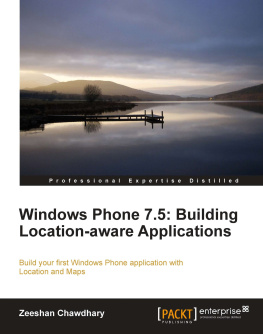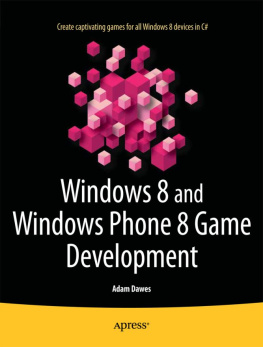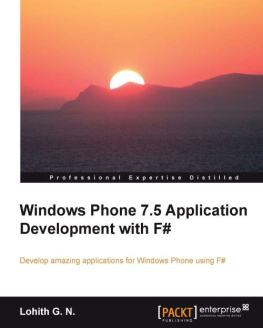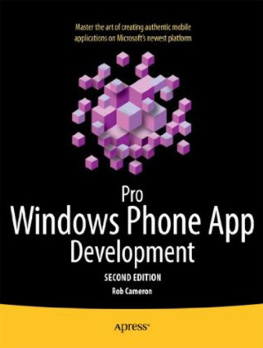Important
This book and Microsoft Silverlight Edition: Programming Windows Phone 7 are fully indexed, print-book versions of a single free, electronic edition titled Programming Windows Phone 7, which you can find on the Microsoft Press blog: is the only section in this Introduction that has been updated.
This book is a gift from the Windows Phone 7 team at Microsoft to the programming community, and I am proud to have been a part of it. Within the pages that follow, I show you the basics of writing applications for Windows Phone 7 using the C# programming language with the Silverlight and XNA 2D frameworks.
Yes, Programming Windows Phone 7 is truly a free download, but for those readers who still love paperas I certainly dothis book will also be available (for sale) divided into two fully-indexed print editions: Microsoft Silverlight Edition: Programming Windows Phone 7 and Microsoft XNA Framework Edition: Programming Windows Phone 7 .
With the money youve saved downloading this book, please buy other books. Despite the plethora of information available online, books are still the best way to learn about programming within a coherent and cohesive tutorial narrative. Every book sale brings a tear of joy to an authors eye, so please help make them weep overflowing rivers.
In particular, you might want to buy other books to supplement the material in this book. For example, I barely mention Web services in this book, and thats a serious deficiency because Web services are likely to become increasingly important in Windows Phone 7 applications. My coverage of XNA is limited to 2D graphics and while I hope to add several 3D chapters in the next edition of this book, I dont really get into the whole Xbox LIVE community aspect of game development. Nor do I discuss any programming tools beyond Visual Studionot even Expression Blend.
My publisher Microsoft Press has a couple additional Windows Phone 7 books coming soon: Windows Phone 7 Silverlight Development Step by Step by Andy Wigley & Peter Foot offers a more tools-oriented approach. Although Michael Strohs Windows Phone 7 Plain & Simple is a guide to using the phone rather than developing for it, I suspect it will give developers some insights and ideas.
Moreover, I also hear that my old friend Doug Boling is working hard on a Windows Phone 7 enterprise-programming book that is likely to be considered his masterpiece. Be sure to check out that one.
Organization
This book is divided into three parts. The first part discusses basic concepts of Windows Phone 7 programming using example programs that target both Silverlight and the XNA framework. It is likely that many Windows Phone 7 developers will choose either one platform or the other, but I think its important for all developers who have at least a little knowledge of the alternative to their chosen path.
The second part of this book focuses entirely on Silverlight, and the third part on XNA 2D. For your convenience, the chapters in each part build upon previous knowledge in a progressive tutorial narrative, and hence are intended to be read sequentially.
My Assumptions About You
I assume that you know the basic principles of .NET programming and you have a working familiarity with the C# programming language. If not, you might benefit from reading my free online book .NET Book Zero: What the C or C++ Programmer Needs to Know about C# and the .NET Framework, available from my website at www.charlespetzold.com/dotnet.
System Requirements
To use this book properly youll need to download and install the Windows Phone Developer Tools, which includes Visual Studio 2010 Express for Windows Phone, XNA Game Studio 4.0, and an on-screen Windows Phone Emulator to test your programs in the absence of an actual device. Get the latest information and downloads at http://developer.windowsphone.com.
You can install these tools on top of Visual Studio 2010, in effect enhancing Visual Studio 2010 for phone development. Thats the configuration I used.
Although you can do quite a bit with the phone emulator, at some point youll want to deploy your programs to an actual Windows Phone 7 device. You can register as a phone developer at http://developer.windowsphone.com and then have the ability to unlock your phone so you can deploy your programs from Visual Studio.
Since late July 2010, Ive had an LG GW910 phone to test the programs in this book. For the record, the final build I installed was 7.0.7003.0.
Using the Phone Emulator
Windows Phone 7 supports multi-touch, and working with multi-touch is an important part of developing programs for the phone. When using the Windows Phone Emulator, mouse clicks and mouse movement on the PC can mimic touch on the emulator, but for only one finger. You can test out multi-touch for real on the phone emulator if you have a multi-touch monitor running under Windows 7.
In the absence of a multi-touch monitor, you might want to explore simulating multi-touch with multiple mouse devices. The site http://multitouchvista.codeplex.com has the download youll need and includes a link to http://michaelsync.net/2010/04/06/step-by-step-tutorial-installing-multi-touch-simulator-for-silverlight-phone-7 that provides instructions.
Windows Phone 7 devices also have a built-in accelerometer, which can be very difficult to simulate in an emulator. Per Blomqvist, the Technical Reviewer for this book, found an application at http://accelkit.codeplex.com that utilizes the webcam and ARToolkit to emulate the accelerometer sensor and feed that data into the Windows Phone 7 emulator through a TCP/HTTP Server, and although neither of us have tried it out, it sounds quite intriguing.








